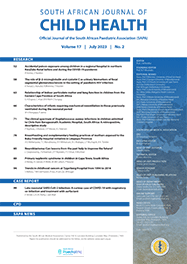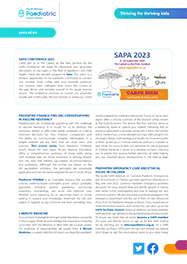Review

Is the World Health Organization’s multicentre child growth standard an appropriate growth reference for assessing optimal growth of South African mixed-ancestry children?
L M Arendse, D Brits, E V Lambert, V E Gibbon
Abstract
In South Africa (SA), it has been estimated that one-third of boys and 25% of girls under the age of 5 years are stunted, according to the World Health Organization (WHO) Multicentre Growth Reference Study. During the past decade, research in developed and developing countries has shown that the international growth standard overestimates stunting and/or wasting when compared with population-specific growth references. Population-specific growth references typically incorporate genetic and environmental factors and can therefore better inform public health by identifying children who may be at risk for malnutrition, or who may be ill. Using the universal growth standard in SA may not be accurately assessing growth. In this article, environmental and genetic factors, and their influence on growth, are reviewed. These points are illustrated through a brief history of the peopling of SA, with an understanding of the socioeconomic and political climate – past and present. We discuss the uniqueness of certain population groups in SA, with contributions regarding some of the shortest peoples in the world and a history of sociopolitical inequities, which may mean that children from certain population groups who are perfectly healthy would underperform using the universal growth standard. Therefore, we suggest that a local population-specific growth reference would serve to better inform public health policies, and address childhood health equity and physical developmental pathways to adult health risk status.
Authors' affiliations
L M Arendse, Division of Clinical Anatomy and Biological Anthropology, Department of Human Biology, Faculty of Health Sciences, University of Cape
Town, South Africa
D Brits, Human Variation and Identification Research Unit, School of Anatomical Sciences, Faculty of Health Sciences, University of the Witwatersrand,
Johannesburg, South Africa
E V Lambert, Division of Clinical Anatomy and Biological Anthropology, Department of Human Biology, Faculty of Health Sciences, University of Cape
Town, South Africa; UCT Research Centre for Health through Physical Activity, Lifestyle and Sport (HPALS), Department of Human Biology, Faculty of Health Sciences, University of Cape Town, South Africa
V E Gibbon, Division of Clinical Anatomy and Biological Anthropology, Department of Human Biology, Faculty of Health Sciences, University of Cape
Town, South Africa
Cite this article
South African Journal of Child Health 2022;16(2):117.
Article History
Date submitted: 2022-07-22
Date published: 2022-07-22
Article Views
Abstract views: 727
Full text views: 396
Comments on this article
*Read our policy for posting comments
here


.jpg)



Comments on this article
*Read our policy for posting comments here